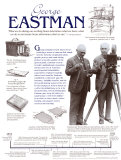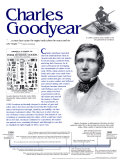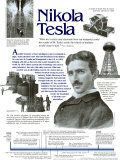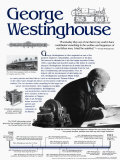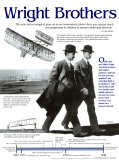|
|
|
|
|
|
|
BOOKS ABOUT TECHNOLOGY & SCIENCE
|
|
|
|
|
|
|
|
|
|
|
|
|
|
|
|
|
|
|
 |
|
|
|
|
|
|
|
Technology’s Past Educational Posters
for the classroom and home schoolers.
|
social studies > history > inventions > TECHNOLOGY'S PAST < science
|
|
The “Technology’s Past” poster series celebrated people responsible for much of our technological history. The posters series, which is now out of print or not available from my sources, was based on the popular book Technology’s Past by Dennis Karwatka. by Dennis Karwatka.
|
|
Alexander Graham Bell
b. 3-3-1847; Edinburgh, Scotland
d. 8-2-1922; Nova Scotia (diabetes)
Alexander Graham Bell's many inventions of sound equipment spring from his lifelong commitment to the concerns of the deaf. Although best known as the inventor of the telephone. Bell usually listed his occupation as “teacher of the deaf.” Many of his ideas paved the way for later innovations. Bell's photo-phone, which sent sound waves by light, anticipated today's fiber obtics, and his principles to impress a magnetic field on a record to reproduce sound were eventually applied in the tape recorder, computer, and CD-ROM. Only years after his death did his ideas for solar heat, air conditioning, and alcohol-based fuel came into general use.
Alexander Graham Bell, who is best remembered as an inventor of the telephone and the first to patent it, was a teacher at the Pemberton Avenue School for the Deaf in Boston.
Alexander Graham Bell quotes ~
• “Before anything else, preparation is the key to success.”
• “When one door closes, another opens; but we often look so long and so regretfully upon the closed door that we do not see the one which has opened for us.”
• “America is a country of inventors, and the greatest of inventors are the newspaper men.”
• “A true inventor can no more help inventing than he can help thinking or breathing.”
• Reluctant Genius: Alexander Graham Bell and the Passion for Invention
|
|
|
|
George Washington Carver
b. c.1865; near Diamond Grove, Missouri
d. 1-5-1943
His epitaph reads “He could have added fortune to fame, but caring for neither, he found happiness and honor in being helpful to the world.”
Geroge Washington Carver, born a slave, achieved an international reputation and became America’s first biotechnologist. Poor health prevented him from performing manual labor, so he read and developed an interest in biology. While teaching at Tuskegee Institute, he found ways to transform the South’s depleted soil into rich, fertile soil. Tobacco and cotton, then the South’s staple crops, stole nutrients from the soil. Travelling by horse-drawn wagon, Carver instructed farmers to rotate their crops and plant peanuts to improve the soil’s quality. The new crop had limited markets, but within a week, Carver devised and developed dozens of uses for the peanut. His research is most responsible for the South’s economic survival.
African American botanist and agricultural educator George Washington Carver developed developing innovative uses for a variety of agricultural crops such as peanuts, soybeans and sweet potatoes and crop-rotation methods for conserving nutrients in soil.
• more George Washington Carver
|
|
|
|
George Eastman
b. 7-12-1854, NY
d. 3-14-1932, NY
“What we do during our working hours determines what we have; what we do in our leisure hours determines what we are.” George Eastman
George Eastman is best known for his introducing a series of cameras that simplified the formerly complicated photographic process and made talking pictures a favorite pastime of the general public. Eastman went on to build a multinational corporation and become one of America’s most important industrialists. Long before employers typically offered such benefits, Eastman established a retirement plan, life insurance, disability benefits, and the first profit-sharing system in the U.S. for his employees. Known almost as well for his philanthropy as he is for his pioneering work in photography, Eastman gave away his entire personal fortune - $75-$100 million - in an effort to foster music, endow learning, and support science research and teaching.
• History Through a Lens posters
• Camera posters
|
|
|
|
Thomas Edison
b. 2-11, 1847; Milan, OH
d. 10-18-1931; NJ
“Genius is 1% inspiration and 99% perspiration.”
His legacy of 3.5 million pages of letters and lab notes documenting 1,093 patents began early in life. As a 12-year-old newspaper publisher, Edison's profits supported lab equipment for experiment. His insatiable curiosity to know, discover, and develop led to his invention of the phonograph, the electric lightbulb, the modern electric power station, the movie camera and projector, and well over 1,000 more inventions. He received more patents for his inventions than anybody else, before or since. Among Edison's collaborators were the other great pioneers in electricity, Nikola Tesla and Lewis Latimer.
• more Thomas A. Edison
|
|
|
|
Henry Ford
b. 7-30-1863, Dearborn, MI
d. 4-7-1947, Dearborn, MI
“Any cusotmer can have a car painted any color that he wants so long as it is black.”- Henry Ford
Henry Ford failed twice at manufacturing before forming Ford Motor Company in 1903, at the age of 40. The company sold an impressive 1,700 cars in its first 15 months. In 1913, Ford inaugurated the first moving assembly line, significantly streamlining production. To reduce labor turnover, Ford announced in 1914 his intention to share $10 million of his company's profits with his workers, more than doubling their salary to an unheard of $5 a day.
• Henry Ford posters
• Inventions that Changed the World posters
|
|
|
|
Charles Goodyear
b. 12-29-1800, Hartford, CT
d. 7-1-1860, NYC
“...a man has cause or regret only when he sows and no one reaps.” Charles Goodyear
Charles Goodyear operated the first retail hardware store in America also took out patents for an air pump, a pontoon boat, and a hay fork. However he is most well known for developing the vulcanization of rubber. In the early 1850s, many products such as boots and coats were made from Brazil’s waterproof gum, but these goods melted and gave off strong odors in warm weather and stiffened and cracked during cold weather. Goodyear became obsessed with finding a way to improve rubber. He first experimented with India rubber and used all his money to finance his experiments. In 1859 Goodyear accidently cropped a mixture of gum and sulfur onto a hot stove and discovered that the heated substance had improved strength, elasticity and stability - he had developed vulcanized rubber. This discovery is often cited as one of history’s most celebrated ‘accidents’. But instead of concentrating on manufacturing the rubber which would have made him a rich man, Goodyear continued to experiment. His numerous patents were constantly infringed and although he was able to establish his rights legally, he died a poor man.
|
|
|
|
Nikola Tesla
b. 7-10-1856; Smiljan, Croatian Krajina
d. 1-7-1943, NYC
Poster Text: “Were we to seize and eliminate from our industrial world the results of Mr. Tesla’s work, the wheels of industry would cease to turn”. - B. A. Behrend
A prolific inventor of keen intelligence and exceptional insight, Tesla patented more than 700 inventions in his lifetime. He was born in Crotia and immigrated to the U.S. in 1884, bringing with him a discovery that would transform the world. By 1874 direct current (DC) technology was used in many industries, but only with minor success. What was needed was an alternating current (AC) motor and unlimited electrical energy to power industry. Tesla’s discovery of the rotating magnetic field principle brought forth the AC motors and polyphase AC, the worldwide standard. He then turned his attention to high frequency research and discovered the four-tuned circuit, the foundation of all radio communication.
Nikola Tesla quotes ~
• “If you want to find the secrets of the universe, think in terms of energy, frequency and vibration.”
|
|
|
|
George Westinghouse
b. 10-6-1846, NY
d. 3-12-1914, NYC
“If someday they say of me that in my work I have contributed something to the welfare and happiness of my fellow men, I shall be satisfied.”- George Westinghouse
George Westinghouse is often regarded as one of the greatest engineers, industrialists, and inventors of his time. His interest in railroads led to his first major invention. Before 1860 a speeding train traveled nearly a mile before it could be stopped. Westinghouse invented an air brake that allowed the engineer to control all brakes instantly form the cab, this revolutionized rail transportation. Next, he helped with the development of alternating current. Westinghouse purchased Nekola Tesla’s AC motor patents and hired him to work on development. Thomas Edison, on the other hand, thought his direct current system could not be outdone. The two became rivals competing for the huge consumer electrical market. After staging several lighting demonstrations, Westinghouse was awarded the contract to install three massive 5,000 hp AC alternators at Niagara Falls. In all, Westinghouse received 361 patents and founded 60 companies in his lifetime.
|
|
|
|
Wright Brothers
“We were lucky enough to grow up in an environment where there was always much encouragement to children to pursue intellectual interests.” Orville Wright
The Wright's Flyer had a ‘tail first' arrangement. Wing-warping allowed the plane to turn, but the brothers found that a bank could cause the plane to spiral into the ground. They added moveable rudders to keep th turn under control.
Orville and Wilbur Wright, American inventors and aviation pioneers, achieved the first powered, sustained, and controlled flight of an airplane in 1903. The brothers built two sturdier, more reliable planes in the next two years, and in 1906 received a U.S. patent for a powered aircraft.
17 December 1903 at Kitty Hawk: Flyer No. 1 rises into the air for the first time. Three flights were made that day. The longest, piloted by Wilbur, was 852 feet and took 59 seconds. ...
• more Wright Bros. posters
• First Flight poster
• Women and Flight Poster
• Amelia Earhart posters
• Tuskegee Airmen poster
• Astronauts posters
• Aviation posters
|
|
|
previous page | top
|
I have searched the web for visual, text, and manipulative curriculum support materials - teaching posters, art prints, maps, charts, calendars, books and educational toys featuring famous people, places and events - to help teachers optimize their valuable time and budget.
Browsing the subject areas at NetPosterWorks.com is a learning experience where educators can plan context rich environments while comparing prices, special discounts, framing options and shipping from educational resources.
Thank you for starting your search for inspirational, motivational, and educational posters and learning materials at NetPosterWorks.com. If you need help please contact us.
|
|
|
|










